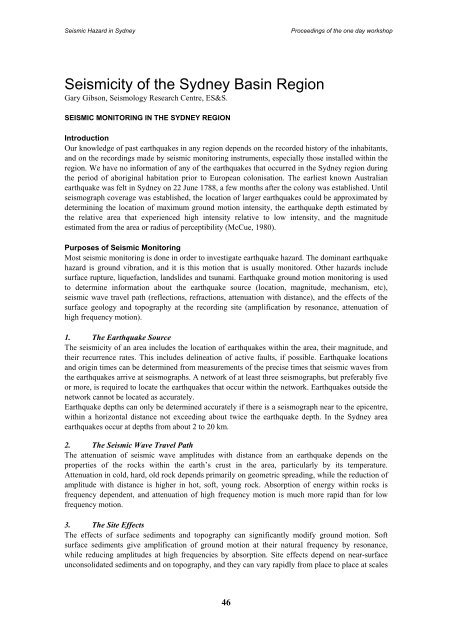Landslides in the Sydney Basin - Geoscience Australia
Landslides in the Sydney Basin - Geoscience Australia
Landslides in the Sydney Basin - Geoscience Australia
- No tags were found...
You also want an ePaper? Increase the reach of your titles
YUMPU automatically turns print PDFs into web optimized ePapers that Google loves.
Seismic Hazard <strong>in</strong> <strong>Sydney</strong>Proceed<strong>in</strong>gs of <strong>the</strong> one day workshopSeismicity of <strong>the</strong> <strong>Sydney</strong> Bas<strong>in</strong> RegionGary Gibson, Seismology Research Centre, ES&S.SEISMIC MONITORING IN THE SYDNEY REGIONIntroductionOur knowledge of past earthquakes <strong>in</strong> any region depends on <strong>the</strong> recorded history of <strong>the</strong> <strong>in</strong>habitants,and on <strong>the</strong> record<strong>in</strong>gs made by seismic monitor<strong>in</strong>g <strong>in</strong>struments, especially those <strong>in</strong>stalled with<strong>in</strong> <strong>the</strong>region. We have no <strong>in</strong>formation of any of <strong>the</strong> earthquakes that occurred <strong>in</strong> <strong>the</strong> <strong>Sydney</strong> region dur<strong>in</strong>g<strong>the</strong> period of aborig<strong>in</strong>al habitation prior to European colonisation. The earliest known <strong>Australia</strong>nearthquake was felt <strong>in</strong> <strong>Sydney</strong> on 22 June 1788, a few months after <strong>the</strong> colony was established. Untilseismograph coverage was established, <strong>the</strong> location of larger earthquakes could be approximated bydeterm<strong>in</strong><strong>in</strong>g <strong>the</strong> location of maximum ground motion <strong>in</strong>tensity, <strong>the</strong> earthquake depth estimated by<strong>the</strong> relative area that experienced high <strong>in</strong>tensity relative to low <strong>in</strong>tensity, and <strong>the</strong> magnitudeestimated from <strong>the</strong> area or radius of perceptibility (McCue, 1980).Purposes of Seismic Monitor<strong>in</strong>gMost seismic monitor<strong>in</strong>g is done <strong>in</strong> order to <strong>in</strong>vestigate earthquake hazard. The dom<strong>in</strong>ant earthquakehazard is ground vibration, and it is this motion that is usually monitored. O<strong>the</strong>r hazards <strong>in</strong>cludesurface rupture, liquefaction, landslides and tsunami. Earthquake ground motion monitor<strong>in</strong>g is usedto determ<strong>in</strong>e <strong>in</strong>formation about <strong>the</strong> earthquake source (location, magnitude, mechanism, etc),seismic wave travel path (reflections, refractions, attenuation with distance), and <strong>the</strong> effects of <strong>the</strong>surface geology and topography at <strong>the</strong> record<strong>in</strong>g site (amplification by resonance, attenuation ofhigh frequency motion).1. The Earthquake SourceThe seismicity of an area <strong>in</strong>cludes <strong>the</strong> location of earthquakes with<strong>in</strong> <strong>the</strong> area, <strong>the</strong>ir magnitude, and<strong>the</strong>ir recurrence rates. This <strong>in</strong>cludes del<strong>in</strong>eation of active faults, if possible. Earthquake locationsand orig<strong>in</strong> times can be determ<strong>in</strong>ed from measurements of <strong>the</strong> precise times that seismic waves from<strong>the</strong> earthquakes arrive at seismographs. A network of at least three seismographs, but preferably fiveor more, is required to locate <strong>the</strong> earthquakes that occur with<strong>in</strong> <strong>the</strong> network. Earthquakes outside <strong>the</strong>network cannot be located as accurately.Earthquake depths can only be determ<strong>in</strong>ed accurately if <strong>the</strong>re is a seismograph near to <strong>the</strong> epicentre,with<strong>in</strong> a horizontal distance not exceed<strong>in</strong>g about twice <strong>the</strong> earthquake depth. In <strong>the</strong> <strong>Sydney</strong> areaearthquakes occur at depths from about 2 to 20 km.2. The Seismic Wave Travel PathThe attenuation of seismic wave amplitudes with distance from an earthquake depends on <strong>the</strong>properties of <strong>the</strong> rocks with<strong>in</strong> <strong>the</strong> earth’s crust <strong>in</strong> <strong>the</strong> area, particularly by its temperature.Attenuation <strong>in</strong> cold, hard, old rock depends primarily on geometric spread<strong>in</strong>g, while <strong>the</strong> reduction ofamplitude with distance is higher <strong>in</strong> hot, soft, young rock. Absorption of energy with<strong>in</strong> rocks isfrequency dependent, and attenuation of high frequency motion is much more rapid than for lowfrequency motion.3. The Site EffectsThe effects of surface sediments and topography can significantly modify ground motion. Softsurface sediments give amplification of ground motion at <strong>the</strong>ir natural frequency by resonance,while reduc<strong>in</strong>g amplitudes at high frequencies by absorption. Site effects depend on near-surfaceunconsolidated sediments and on topography, and <strong>the</strong>y can vary rapidly from place to place at scales46
















